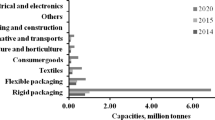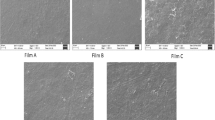Abstract
The acceptability of a new product is decided by its performance, level of improvement in quality and economy of production. The basic aim of generating micro pores in a textile structure is to provide better thermo-physiological comfort by enhancing the breathability and hence improving moisture management behaviour. In the present study, an attempt has been made to create a relatively more open structure through removal of a component. A comparative assessment with a homogeneous and parent yarn was also made. Yarns of two linear densities, each from ring and vortex spinning systems were produced using 100 % polyester and 80:20 polyester/cotton blend. The modified yarn was produced by removing a component, viz; cotton, by treatment with sulphuric acid from the blended yarn. The knitted fabric from modified yarn was found to show significant improvement in air permeability, water vapour permeability and total absorbency while the wicking characteristic was found to decline.




Similar content being viewed by others
References
A. Mukhopadhyay, S.M. Ishtiaque, D. Uttam, Impact of structural variations on pre-hollow/micro-porous yarn’s tensile and physical properties. J. Eng. Fibers Fabr. 7(1), 62–68 (2012)
A. Das, S.M. Ishtiaque, R.P. Singh, Packing of micro-porous yarns. Part II: optimization of fabric characteristics. J. Text. Inst. 100(3), 206–217 (2009)
J. Andrysiak, K. Sikorski, E. Wilk, M. Matusiak, Investigation of an innovative “Cotton Hollow” yarn. Fibres Text. East. Eur. 22(6), 33–37 (2014)
L. Benisek, P.R. Harnett, M.J. Palin, Influence of fibre and fabric type on thermophysiological comfort. Melliand Textilber. Int. (Deutscher Fachverlag) 68(12), 878 (1987)
A.P. D’Silva, C. Greenwood, S.C. Anand, D.H. Holmes, N. Whatmough, Concurrent determination of absorption and wickability of fabrics: a new test method. J. Text. Inst. 91(1), 383–396 (2000)
Holme I (2002) Survival 2002. Textile month: textile technology complete, p. 35
Holme I (2002) Survival 2002. Performance garments. Textile Horizons, Vol 5/6, p 7–8
J. Hu, Y. Li, K.W. Yeung, A.S.W. Wong, W. Xu, Moisture management tester: a method to characterize fabric liquid moisture management properties. Text. Res. J. 75(1), 57–62 (2005)
Q. Zhuang, S.C. Harlock, D.B. Brook, Transfer wicking mechanisms of knitted fabrics used as undergarments for outdoor activities. Text. Res. J. 72(8), 727 (2002)
W. Wardiningsih, O. Troynikov, Influence of cover factor on liquid moisture transport performance of bamboo knitted fabrics. J. Text. Inst. 103(1), 89–98 (2012)
O. Troynikov, W. Wardiningsih, Moisture management properties of wool/polyester and wool/bamboo knitted fabrics for the sportswear base layer. Text. Res. J. 81(6), 621–631 (2011)
A. Bivainytė, D. Mikučionienė, Investigation on the air and water vapour permeability of double-layered weft knitted fabrics. Fibres Text. East. Eur. 19(4), 69–73 (2011)
J. Abramavičiūtė, D. Mikučionienė, R. Čiukas, Static water absorption of knits from natural and textured yarns.: statyczna absorpcja wody dzianin z włókien naturalnych i teksturowanych. Fibres Text. East. Eur 19(3), 60–63 (2011)
E. Oner, H.G. Atasagunb, A. Okura, A.R. Be-denc, G. Durur, Evaluation of moisture management properties on knitted fabrics. J. Text. Inst. 104(7), 699–707 (2013)
Ortlek HG, Kiliç GA (2010) Comparison of yarn properties produced on different ring spinning methods. Abstracts of the Fiber Society Symposium, p 139–140
G. Basal, W. Oxenham, Effects of some process parameters on the structure and properties of vortex spun yarn. Text. Res. J. 76(6), 492–499 (2006)
G.K. Tyagi, G. Krishna, S.B. Bhattacharya, P. Kumar, Comfort aspects of finished polyester-cotton and polyester-viscose ring and MJS yarn fabrics. Indian J. Fibre Text. Res. 34(2), 137–143 (2009)
A.W. Adamson, Physical Chemistry of Surfaces (Wiley, New York, 1967)
P. Kumar, S.K. Sinha, S. Ghosh, Moisture management behavior of modified polyester/wool fabrics. Fash. Text. 2(5), 1–17 (2015)
N. Erdumlu, C. Saricam, Wicking and drying properties of conventional ring- and vortex-spun cotton yarns and fabrics. J. Text. Inst. 104(12), 1284–1291 (2013)
B. Das, A. Das, V.K. Kothari, R. Fangueiro, M. Araujo, Studies on moisture transmission properties of PV-blended fabrics. J. Text. Inst. 100(7), 588–597 (2009)
W.E. Morton, J.W.S. Hearle, Physical Properties of Textile Fibers (The Textile Institute, Manchester, 1962), p. 170
Author information
Authors and Affiliations
Corresponding author
Rights and permissions
About this article
Cite this article
Sharma, N., Kumar, P., Bhatia, D. et al. Moisture Management Behaviour of Knitted Fabric from Structurally Modified Ring and Vortex Spun Yarn. J. Inst. Eng. India Ser. E 97, 123–129 (2016). https://doi.org/10.1007/s40034-015-0075-z
Received:
Accepted:
Published:
Issue Date:
DOI: https://doi.org/10.1007/s40034-015-0075-z




